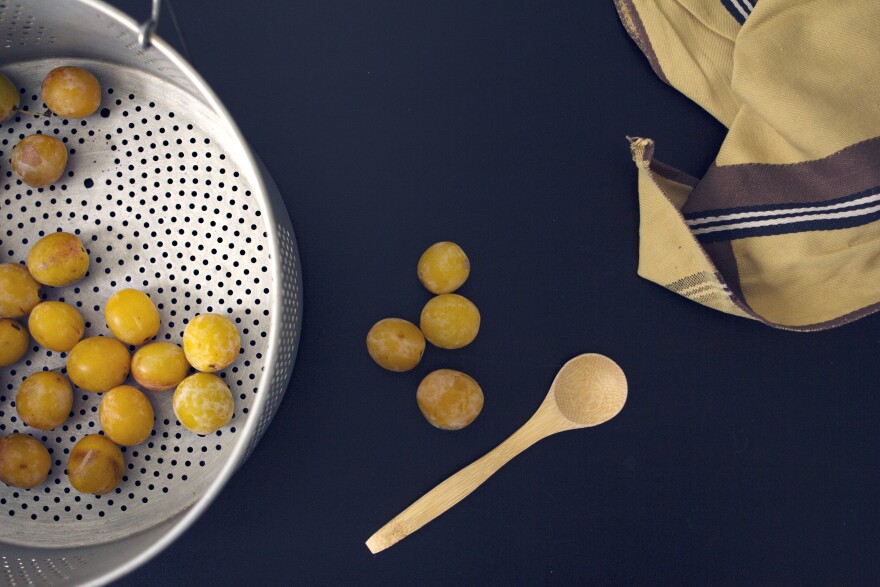On this week's Bubbler Talk, we dig into a botanical mystery involving a 'banned' tree, stinky fruit, and the age of the dinosaurs.
Listener Vanessa Radlinger noticed something out of place in Milwaukee's Third Ward: what she presumed to be a mirabelle plum tree -- which she thought was banned in the US.
The mirabelle plum brought back memories for Vanessa who first saw one of the trees while growing up in Germany.
Before we get into the tree's legal status, let's find out what the big deal is about the mirabelle plum tree.
"It's French, so it has to be good."
Tom Conway owns a fruit tree farm in Washington state and has eaten a mirabelle plum. "[The plum] has one of those reputations," he says. "Even before I tasted one [I] kind of went, ‘Oooh, mirabelle'... it’s French, so it has to be good."
The fruit originated in France's Lorraine region and is used for preserves, tartes, and even plum brandy. "The mirabelle, at least the ones I’ve had, they’re subtle, they have a light sweetness," Tom says. "They’re not a cloying taste of ‘Oh man, this is a sugar bomb."

Does the US really ban mirabelle plum trees?
As to whether the tree is prohibited in the U.S., here's what representatives of the USDA had to say:
"Fresh fruits and vegetables for food and live plants and seeds are regulated by the USDA to prevent insects, plant diseases, and other pests from entering the US. Fresh plums are not allowed from France, and the seeds are restricted. Live plum trees are prohibited."
So if you are in the U.S., don't plan on eating a mirabelle plum from the Lorraine region anytime soon, or any plum grown in France for that matter.
However, Sam Benowitz of Raintree Nursery in Washington state says there are lots of U.S. grown plums to choose from, even mirabelle cultivars (cultivated varieties). "We offer mirabelle plums, and have for years. They’re a great small plum," he explains, "You can get a tree from a reputable nursery that’s already growing here in the United States.”
"I wouldn't be surprised if Thomas Jefferson didn't have them at Monticello. Early in the history of the country, one of the prized commodities for anyone traveling, who was a landowner, was to find varieties of fruit trees or berries," Tom says. "They would bring back small cuttings or scions, which is the wood you can graft to another tree."
Back in Milwaukee...
Because there are lawful mirabelles in the U.S., local arborist Melinda Myers paid a visit to the tree growing in the Third Ward. She would know if it actually was what question asker Vanessa thought it was.

To get to the bottom of this mystery, Melinda looked at the clues: stinky fruit, branches with spurs, fleshy seeds, and a unique leaf.
So, after all of this hullaballoo, she concluded that the tree is not a mirabelle plum but a ginkgo biloba. Which is still pretty neat!

The ginkgo's origins reach all the way back to the dinosaur age. Once thought extinct, they were rediscovered and made their way across Asia. Humans first cultivated the tree about 1,000 years ago.
And, ginkgo biloba trees are fairly common in cities like Milwaukee. During the 1700s in London, they were used to line streets and survived the industrial revolution. "So all of a sudden, cities were thinking these are great trees: They don’t have insect problems, they tolerate pollution. So they started planting them and then they became popular," Melinda explains.
“But they do look very much like a plum, so I can see why you think that," she says to Vanessa. "And you probably just thought they were rotten plums and that’s why they smelled so bad."
READ: The Life Story of the Oldest Tree on Earth
But the stinky fruit was an issue for cities, so some started taking cuttings from only male plants to avoid the fruit. After they mature, ginkgos that start out male can spontaneously switch to female. "And they think it’s part of its survival technique 'Hey, there’s not enough female to male ratio so some of us need to change sex and become female!'” Melinda adds.

Is there a female ginkgo problem in Milwaukee?
"The city of Milwaukee works very hard. They don’t want to have stinky fruit, people complaining. Some cities like Seoul, South Korea hire people to come and clean the fruit up. Some cities spray, which is expensive and kind of ruins the whole environmental greening movement," she says. "So a lot of cities are trying to get people to just embrace them."
READ: South Korea: Seoul Grapples with Smelly Ginkgo Problem
Fun fact: The tree's seeds and leaves are thought to keep your memory sharp.
Would question asker Vanessa rather have a tree that bears luscious, tasty fruit, or a tree that has stinky fruit but gives you a good memory?
"I really wish it was a mirabelle plum tree!"
Have a question you'd like WUWM to answer? Submit your query below.
_






